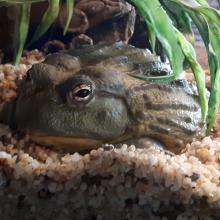Pyxicephalus adspersus

Conservation Status:
Least Concern
Range:
Sub-Saharan Africa
Habitat:
Grassland and savannas
The name “Pixie Frog” was derived from its genus name, but these are commonly called African Bullfrogs. The Pixie Frog is an ambush predator that waits for food, but will eat many types of small animals. This species eats arthropods, fish, mice, lizards, and sometimes other frogs. The frog defends itself by puffing up with air.
The most obvious characteristic that differentiates Pyxicephalus from other frogs is its size. It is one of the biggest frogs, second only to the Rana Goliath. Individuals can weigh up to 2 kg (4.4 lbs). Unlike most other species of frog, the Pixie Frog male is larger than the female. The male can be up to 24 cm (9.5 in.) long and the females are about 12 cm (4.45 in.). Their skin color is a dull green; the males have yellow throats and the females have throats are cream-colored. Juveniles differ in that they are bright green and have a yellow stripe down their back. This stripe fades away as they mature in about one and a half to two years. Also, older frogs have more obvious skin folds than the younger ones.
The body of the frog is very broad, with a short rounded snout, protruding jaw, and tooth-like projections in its lower jaw. It has a large mouth, sharp “teeth” and very little webbing on its feet.
The males make calls only during the rainy season, which is when they come out of estivation to breed in pools of water. The call of the Pixie Frog is composed of loud, throaty bellows and deep grunts. These frogs can get rather territorial during mating and begin their mating calls only when they have established their territory.
Pixie frogs live in tropical and subtropical savannas, near fresh water sources. During temperature extremes and dry seasons, they live in burrows underground to escape the heat or cold, tightly wrapped in a cocoon made from dead skin cells, which protects them from moisture loss. Pixie frogs can survive underground in a dormant state for many months, emerging when the rainy season begins.
